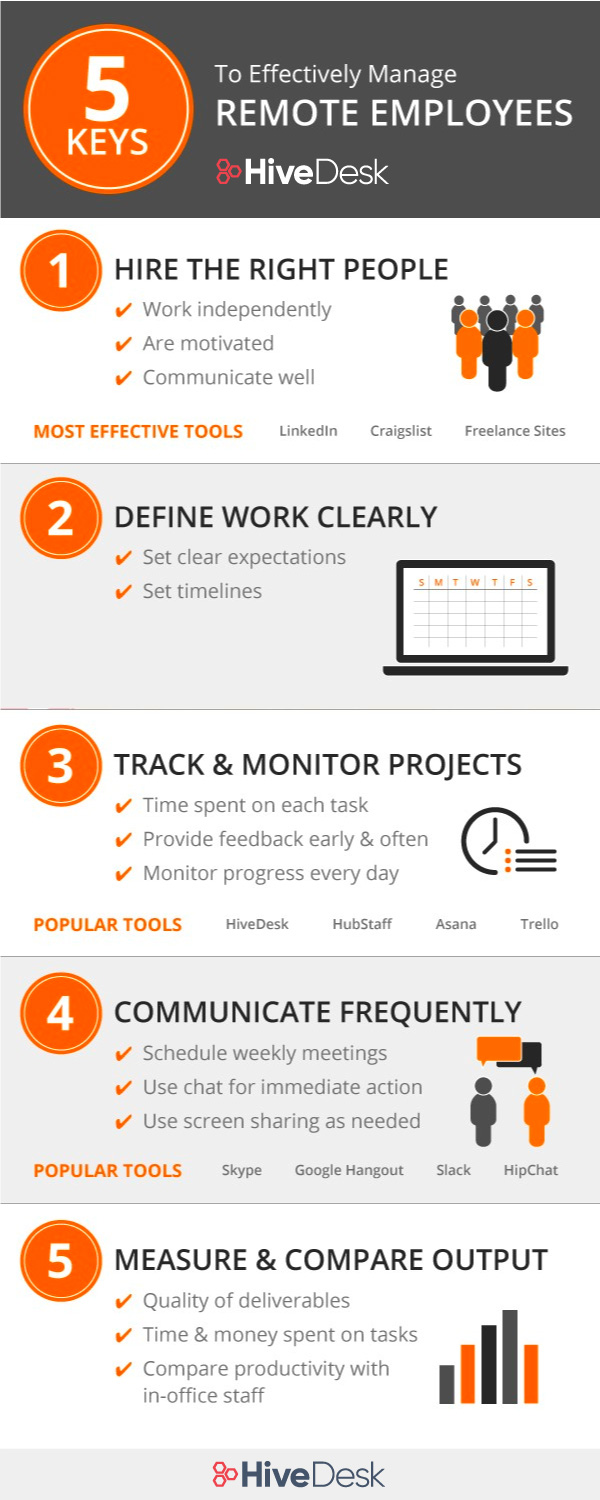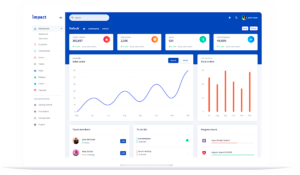5 keys to managing remote employees
5 min read
Managing remote employees is not easy. That’s why we surveyed over 40 small businesses to find best practices for managing remote employees.
Working remotely is a win-win for both the employer and the employee if you use these best practices to manage your remote workforce.
We created HiveDesk almost 10 years ago to help small and medium businesses manage their remote employees. Remote work was just taking off in the US and businesses were looking for help in managing remote employees. We have come a long way since then both in terms of our product evolution and market acceptance.
Today, businesses across the world manage their remote employees with HiveDesk. It’s easy to use and is the most affordable remote employee management tool in the market.
Remote work was growing in popularity even before the pandemic hit us in 2020. Since then, almost every business around the world has embraced it. Today, most companies offer employees the option to work remotely.
Employees love the flexibility of working remotely due to better work-life balance. Companies gain from increased employee loyalty and productivity.
But businesses also face challenges in managing remote employees as they lack critical information about remote employees:
- How long are the employees working?
- Are they working on the right projects and tasks?
- Have they accomplished what was expected of them?
- Are remote employees as productive as those working in office?

Download the Work-from-Home IT Toolkit
Are you facing the same challenges in managing remote employees?
You’ll find answers to these questions in this blog post.
- Ability to hire the best talent irrespective of location
- Savings on office expenses
Most businesses also said that remote employees are as productive, if not more, than employees working in the same office.
But hiring remote employees also has its challenges:
- Managing remote employees requires different skill as you can’t physically monitor them.
- Reviewing work and providing feedback is difficult.
- If you have multiple remote employees, it’s hard to keep them moving in the same direction.
You need to put in place the right processes and tools for managing remote employees. Here is how you can do it well:
1. Hire employees with the right attitude
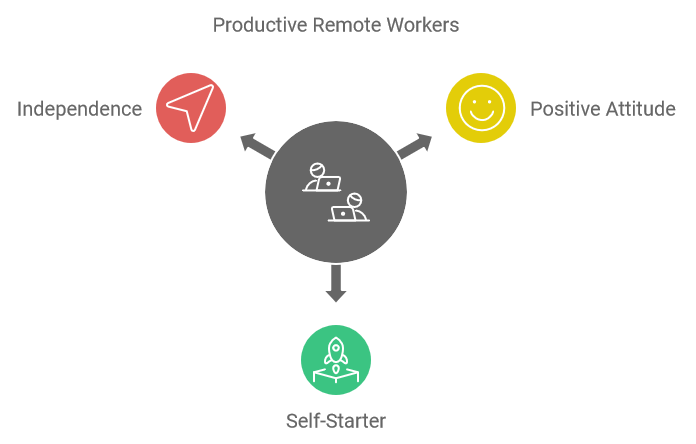
Let’s face it- not everyone can be a remote worker. Everyone loves the flexibility of working remotely. But only some have the attitude and discipline to be productive remote employees.
When hiring, look for people who can work independently. It’s always easier to manage a self-starter, more so when working remotely.
Good remote workers have a positive attitude and are motivated to do their job well. You don’t want people who always need a push to complete the task. It will be a nightmare if you have to micro-manage your remote employees. A good employee will not wait for you to ask for updates or assign tasks. Rather, he or she will proactively update you on the status and schedule.
Always hire employees who communicate well as it’s the key to a successful remote team. The better your remote employees understand your instructions and communicate with you, the easier it will be to manage them.
Here are some tools/services you can use to search for and hire remote workers:
- LinkedIn, the social network for professionals, is also one the best places for hiring workers.
- Craigslist is a classifieds website where you can post jobs. It is particularly great for hiring remote workers in the US.
- You can use freelance sites like Upwork, Toptal, Freelancer to hire freelancers as per your needs. However, these sites charge a fee from both employer and employee. In most cases, you’ll better off hiring remote employees from LinkedIn and using a tool like HiveDesk for managing them.
2. Clearly define the expectation
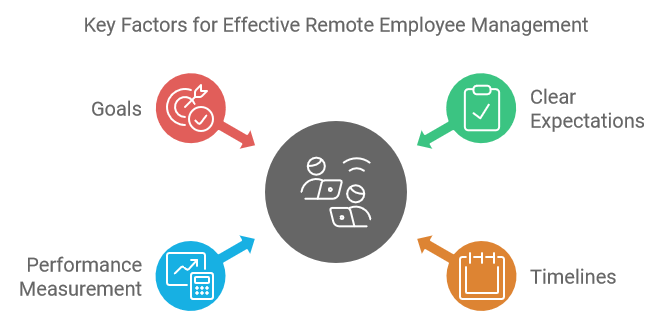
Explain what you want from your remote employees and when you want it.
This sets clear expectations and timelines for your remote employees. They will know how you will measure their performance and what goals they need to meet.
Businesses in our survey identified it as one of the most critical factors in managing remote employees.
3. Track progress of your remote employees
Be sure to track the progress of your remote employees daily. Stay on top of project status and eliminate nasty surprises later by reviewing work every day.
Give your remote workers periodic feedback to ensure they are heading in the right direction.
Here are some tools you can use to track time, project status, and tasks:
- HiveDesk is a time tracking software for managing remote employees. It creates automatic timesheets, captures screenshots, tracks project & tasks, and measures productivity. Start your 14-day free trial.
- Asana is a project management software that allows you to organize to-do lists, projects & meeting information, conversations, and emails in an easy-to-read dashboard.
- Trello is a project management tool that allows you to manage tasks and projects.
4. Communicate frequently
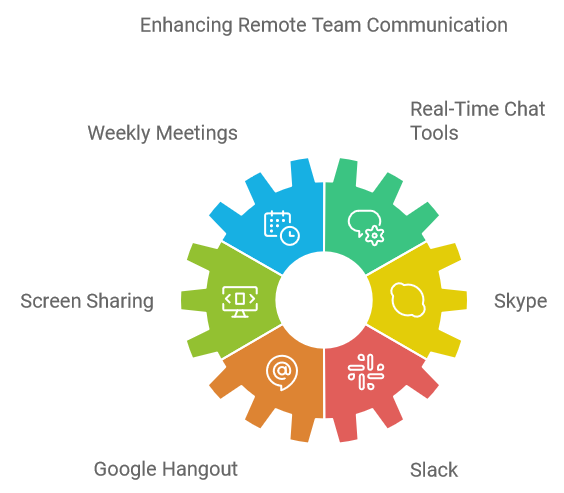
It’s hard to keep your remote employees on the same page if you without communicating frequently.
You cannot walk up to a remote employee to discuss issues. Therefore, it’s important for your remote team to communicate frequently. You can identify issues early and manage them better with frequent communication.
Everyone in your remote team should be easily accessible through email, chat, phone or a team messaging tool. It’s a good idea to:
- Schedule weekly meetings with your remote employees.
- Use a chat tool to discuss issues in real time.
- Use screen sharing as needed to explain tasks
You can use one or more of the following tools to improve communication with your remote employees:
- Skype is a communication and collaboration tool that combines video, voice and text chat.
- Google Meet is a free communication platform from Google which includes instant messaging, video chat, & SMS.
- Slack is a team messaging app ideal for remote teams. It has a free version that works well for small teams. Most businesses in our survey use Slack and found it extremely useful in managing remote workers.
5. Measure performance and compare output
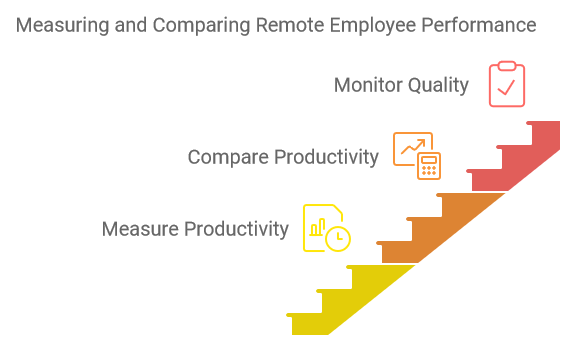
If you want to get the most out of your remote employees, you need to measure their performance as least once a month.
Analyze how much time an employee spends on each task. You can use the data to measure the productivity of remote employees in your team. You can also see if your remote employees are as productive as those working in the office.
You should also monitor the quality of output from your remote employees. If the team delivers quality output the first time, you will save time and money spent on fixing it later.
Share your thoughts about managing remote employees
Please share it with your team and followers on social media. You can also embed this infographic on your site by copying and pasting the embed code below:
<blockquote class=”embedly-card” data-card-key=”5c22c200071a4bc3be70956bd26c7b83″ data-card-controls=”0″ data-card-type=”article-full”>
<h4><a href=”https://www.hivedesk.com/blog/managing-remote-employees/”>Managing Remote Employees – 5 Keys to Improve Productivity</a></h4>
Do you need help managing remote employees? We surveyed a number of small businesses who employ remote employees to find best practices you can implement in your own business. Companies in our survey say working remotely is a win-win for both the employer and the employee.</blockquote>
<script async src=”//cdn.embedly.com/widgets/platform.js” charset=”UTF-8″></script>

